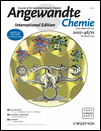Detecting Force-Induced Molecular Transitions with Fluorescence Resonant Energy Transfer†
Support was provided by a National Institutes of Health National Research Service Award (P.B.T.), the MIT/NIGMS Biotechnology Training Program (R.R.B.), the Singapore–MIT Alliance (M.B., Y.F., P.M.), the National Institutes of Health (J.M.F.), the National Science Foundation (P.M.), and the W.M. Keck Foundation (M.J.L.).
Graphical Abstract
Don't FRET: The first successful combination of optical-tweezers force microscopy and single-molecule fluorescence resonant energy transfer (FRET) is demonstrated with a force sensor based on a DNA hairpin (see picture). As the hairpin is opened and closed by the optical tweezers, the structural change is simultaneously monitored by the FRET emission from fluorescence labels.





